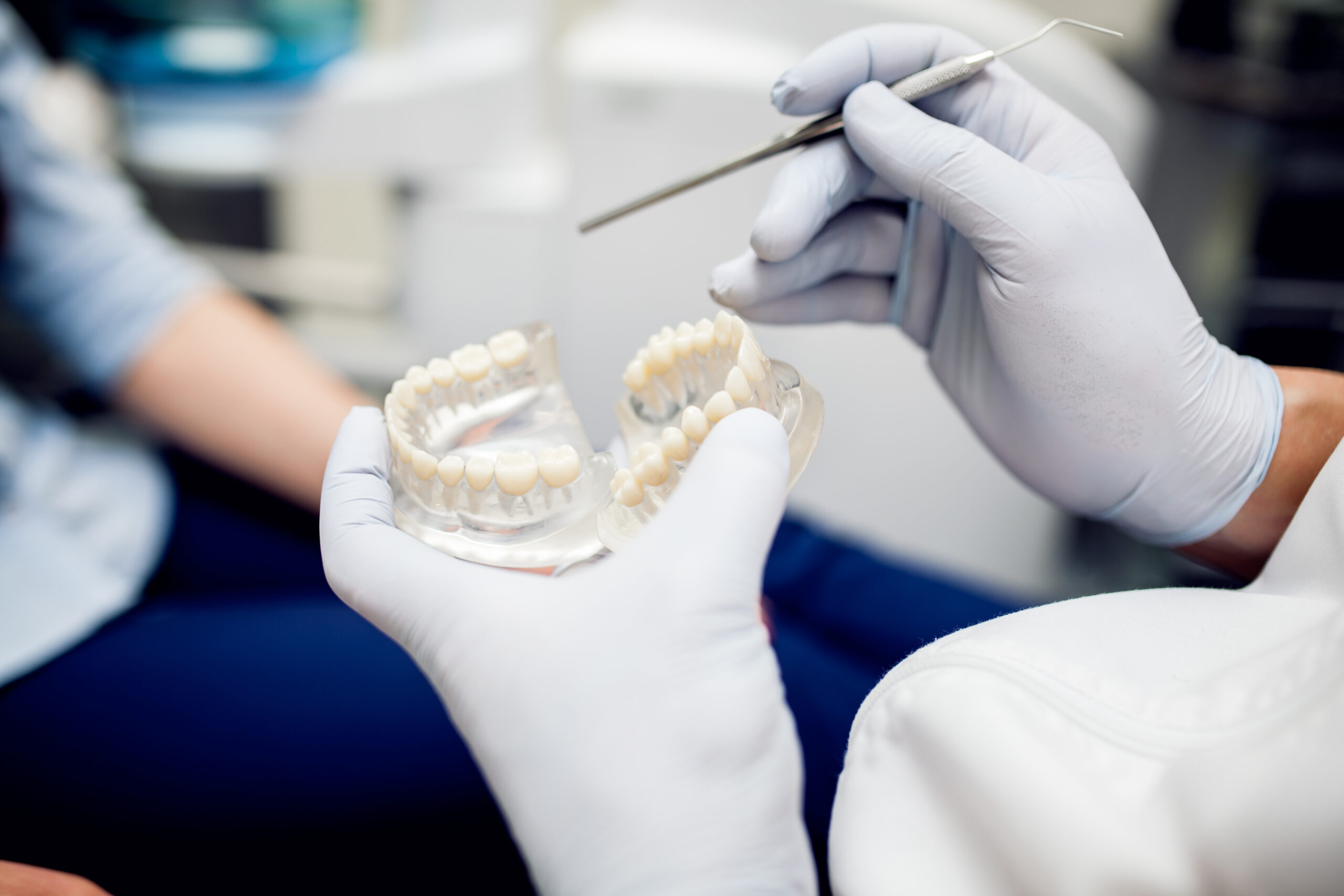
Close


A dental implant (also known as an endosseous implant or fixture) is a prosthesis that interfaces with the bone of the jaw or skull to support a dental prosthesis such as a crown, bridge, denture, or facial prosthesis or to act as an orthodontic anchor. The basis for modern dental implants is a biological process called osseointegration, in which materials such as titanium or zirconia form an intimate bond to the bone.The implant fixture is first placed so that it is likely to osseointegrate, then a dental prosthetic is added. A variable amount of healing time is required for osseointegration before either the dental prosthetic (a tooth, bridge, or denture) is attached to the implant or an abutment is placed which will hold a dental prosthetic or crown.
Success or failure of implants depends primarily on the thickness and health of the bone and gingival tissues that surround the implant, but also on the health of the person receiving the treatment and drugs which affect the chances of osseointegration. The amount of stress that will be put on the implant and fixture during normal function is also evaluated. Planning the position and number of implants is key to the long-term health of the prosthetic since biomechanical forces created during chewing can be significant. The position of implants is determined by the position and angle of adjacent teeth, by lab simulations or by using computed tomography with CAD/CAM simulations and surgical guides called stents. The prerequisites for long-term success of osseointegrated dental implants are healthy bone and gingiva. Since both can atrophy after tooth extraction, pre-prosthetic procedures such as sinus lifts or gingival grafts are sometimes required to recreate ideal bone and gingiva.
The final prosthetic can be either fixed, where a person cannot remove the denture or teeth from their mouth, or removable, where they can remove the prosthetic. In each case an abutment is attached to the implant fixture. Where the prosthetic is fixed, the crown, bridge or denture is fixed to the abutment either with lag screws or with dental cement. Where the prosthetic is removable, a corresponding adapter is placed in the prosthetic so that the two pieces can be secured together.
The risks and complications related to implant therapy divide into those that occur during surgery (such as excessive bleeding or nerve injury, inadequate primary stability), those that occur in the first six months (such as infection and failure to osseointegrate) and those that occur long-term (such as peri-implantitis and mechanical failures). In the presence of healthy tissues, a well-integrated implant with appropriate biomechanical loads can have 5-year plus survival rates from 93 to 98 percent and 10-to-15-year lifespans for the prosthetic teeth. Long-term studies show a 16- to 20-year success (implants surviving without complications or revisions) between 52% and 76%, with complications occurring up to 48% of the time. Artificial intelligence is relevant as the basis for clinical decision support systems at the present time.Intelligent systems are used as an aid in determining the success rate of implants.
Veneer is a thin, but very durable layer of material placed on the front surface of a damaged tooth. Veneers can hide any defect including crooked or cracked teeth, gaps between teeth, sealants, stains on enamel. In terms of appearance, colour and texture, veneers are completely indistinguishable from white enamel of a healthy tooth. Dentists put them in such a way that they cover not only the front side of a tooth, but also its lower edge. This is why no one will ever notice that a tooth was treated by an experienced dentist. In fact, you can choose any colour you like. For instance, veneers that copy the shade of your own enamel will let you hide any defects of your teeth while the snow-white veneers placed over the front teeth will give you that gorgeous Hollywood smile!


Cosmetic dentistry is generally used to refer to any dental work that improves the appearance (though not necessarily the functionality) of teeth, gums and/or bite. It primarily focuses on improvement in dental aesthetics in color, position, shape, size, alignment and overall smile appearance. Many dentists refer to themselves as “cosmetic dentists” regardless of their specific education, specialty, training, and experience in this field. This has been considered unethical with a predominant objective of marketing to patients.
Here are some of the most popular options:
Find the best care for your dental and facial aesthetics in the heart of Cappadocia.

Tailored smile enhancements using advanced techniques to align aesthetics with your unique facial features and style.

Replace missing teeth with durable, natural-looking implants that restore both function and appearance seamlessly.

Achieve a radiant smile with teeth whitening, veneers, and other treatments designed to perfect the look of your teeth.

Straighten your teeth with modern braces or Invisalign for a healthy, aligned smile that improves both function and aesthetics.

Revitalize your appearance with Botox, dermal fillers, and non-surgical treatments to achieve a youthful, glowing look.

Enhance facial harmony with expert rhinoplasty, focusing on both aesthetic improvements and functional breathing issues.

Hear from Hundreds of Patients Who Have Found Their Perfect Smile with Us
© Copyright 2024 powered by Digiatlon Creative Media Agency Co.